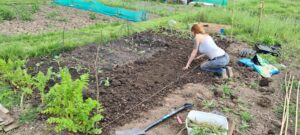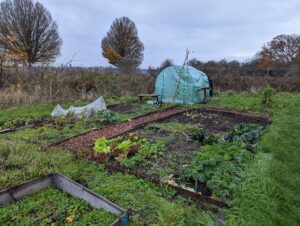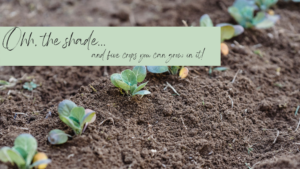Learning how to plan your garden year has never been easier!
It can be completely overwhelming when you want to start growing your own food. The internet is full of contradicting information.
I took my first allotment plot on this year and my first year has been full of successes and failures – but mostly lessons!
This time, I’m ready. I know what I’m going to grow, where I’m going to grow it, as well as common pests that occur on my plot.
Luckily, I’m here to help! Following my simple breakdown will make your lives easier and help you feel more prepared.
Keep reading to plan your garden year with me!
The first step to plan your garden year is to take a look at the space you have to grow in.
The best part about growing is that you can grow however big or small you have to grow in. Whether you have acres or a balcony, you can grow delicious, organic food.
There are a couple of things you need to pay attention to first when planning your garden. These will aid in the success of your crops!
Your space
For myself, my primary space is a 6x15m allotment plot. Which is a fair size!

Last year was my first on the plot and I didn’t know the space at all.
I cleared an area, I planted in what I had at the time, and that was that. I had no plan or real direction for how I wanted anything to look. I didn’t have any idea how the sun would hit my space from which direction. And I definitely didn’t know what had been planted in the space before me. Strangely, a row of parsnips appeared along one part of my plot that I definitely didn’t plant!
Take a good look at the space you have to grow in. For smaller spaces, you can make the most of where you have by growing vertical crops.
Climbing beans, climbing tomatoes, cucumbers and peas are all prolific croppers that you can grow in a small space – add a trellis or canes for support!
The sun
The light you have in your space plays a huge part in the success of your crops. Too little and your crops won’t grow as well as they could, and too much could cause your plants to wilt.
If your space gets full sun all day, make the most of this by choosing sun-loving crops such as aubergine, courgette, and squashes will do incredibly well.
Your warm loving crops and root vegetables will do best when positioned to receive maximum sunshine.
Tip: take a notepad into your garden at various times of the day and jot down where the sun hits and where shadows are cast!
Draw out your space;

If you’re anything like me, planning your garden will be easier with a visual.
You can skip to a slideshow of my garden year plan in action by clicking here!
Whether this is a drawing of a space you already have, or what you’re looking to create; take some time to design your dream garden.
Make sure it’s realistic to avoid disappointment!
The bottom half of my plot this year was used on failed sweetcorn, and a large plot of swiss chard. The rest was and still is a weedy mess.
I hope to get this cleared eventually, but for now, I’m focusing on where I’ve already cultivated to make it easier for myself.
Take a good look at where you want to grow your crops, and move on to the next step!
Grow what you like to eat!
This year, I’ll be focusing on growing a condensed list of the food I like to eat.
A big mistake I find people make is growing something they’ve been told is good for beginners – even if it’s something they don’t enjoy.
 The idea is if you grow what you like to eat, you’ll put more effort into your garden for the reward of good food at the end!
The idea is if you grow what you like to eat, you’ll put more effort into your garden for the reward of good food at the end!
This year, I’m implementing some self control. I’ll be dividing my crops into two categories:
- ‘Must Have’ crops – with no more than two different varieties of each.
- Two or three new crops – These will be something I’ve never grown before and would love to try.
I’m hoping that sticking to these two rules will help me avoid overwhelm; as well as mixing up my varieties like last year!
Grab a notepad and pen, and make a note of what you want to grow.
As you can see from my allotment plan above, I have a few beds to fill!
My ‘must have’ list is quite long for this reason. I have 14 beds on my plot ready to plant into, and 14 ‘must have’ crops.
I also have two polytunnel spaces – one is in a very sorry state and may be relegated to tool storage.
The second, new polytunnel (which I need to erect!) will house the watermelons and chilli peppers.
This leaves one spare bed for new crops – in this case patty pans.
Research, research, research.
You’ve surveyed your space, you’ve picked your crops, and now it’s time to understand when you can sow and plant your chosen varieties.
If you’re new to growing, the back of the seed packet will become your new best friend.
Most, if not all, information you need for a successful crop will be found here.
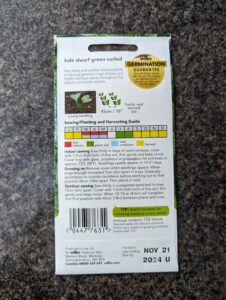 For example, take a look at the packet of dwarf kale seeds on the right.
For example, take a look at the packet of dwarf kale seeds on the right.
You’ll find when to sow both indoor and out, how deeply, and how to care for your seedlings into mature plants.
Some seed packets are more informative than others. If there’s any information your seed packet is lacking, a quick internet search on your crop and variety should bring up everything you need.
How many plants do you need?
Unfortunately, this isn’t something I’d be able to help you with. It will all depend on the space you have and the amount of people you’ll be looking to feed – but it’s definitely worth thinking about when planning your garden year!
When doing your research, it’s a great idea to see how prolific your chosen varieties are, as well as how big the plants will get!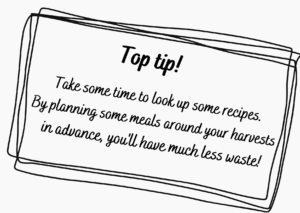
For example, courgettes and chilli peppers are renowned for throwing out a large amount of fruits.
So much so, that my four courgette plants this year were far too much for me as a single person and the plants themselves were HUGE. This year, I’ll be sticking to just the one!
The good news is that any surplus crops needn’t go to waste. Give the extra produce away to friends, freeze or dehydrate some crops, or batch cook and freeze your favourite meals.
Put everything together!
Let’s have a quick rundown on our steps.
- Determine your space and light
- Choose your varieties
- Research your varieties for optimum planting success
- How many plants do you need?
Once you’ve got all these steps down – you can put together a rough plan of the best place to plant everything. Here’s how I’ve planned mine.
- My space:
16 beds, with the sun casting a shadow to the right of the polytunnels.
– Since I know this is the case, I’ll try to keep my taller crops to the right of my smaller crops to avoid casting shadows over them. - My visual plan is drawn up to show me where I have available to plant.
– 14 available beds, plus two beds in my polytunnel. - I’ve picked my crops: Garlic, Onions, Cauliflower, Broccoli, Peas, Beans, Chilli peppers, Courgettes, Butternut Squash, Kale, Lettuce, Cabbage, Carrots, Parsnips, Patty pans and Watermelons.
- I’ve done my research – I know what my chosen varieties and how many I need!
– as many as I can fit into my beds. I’ll be preserving for the winter months.
Where to plant?
The hardest parts are done!
Now it’s time to plan where you want to plant each crop.
Pay careful attention to where the shade lands in your garden. Be sure to plant smaller crops on the correct side of tall ones!
Remember, you can double the use of your small space by underplanting with shorter crops.
Depending on which direction your sun hits, shade tolerant leafy greens are ideal.
How to plan your garden: My entire year!
I’ve put together a super cute little presentation detailing everything I’ve gone over in this blog post, and how I’ve been able to plan my garden year.
If the presentation isn’t working for you, you can click HERE for a PDF copy!
I really hope this process has managed to unjumble some of the panic that we all feel when we just don’t know where to start!
This process works for me as I have everything in front of me, what I need to plant and when! But feel free to take this and run with it however you want to!
Start your new year off right, and as always, Stay Wild x

